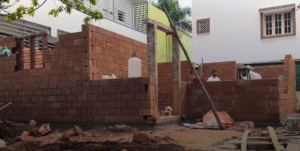Eco Homes in Bangalore: A Practical Guide to Building a Home That Saves Energy & Money
Building a home isn’t just about walls and a roof—it’s about long-term comfort, health, and running costs. In Bengaluru’s climate (hotter summers, irregular rainfall, rising electricity demand), eco-friendly homes offer a smart, future-ready alternative. This guide explains how to design and build a sustainable home that reduces bills, improves comfort, and treads lighter on the planet—with proven practices we use at Madilu Construction.

Why Eco Homes Matter in Bangalore
Bengaluru families are prioritizing lower electricity bills, healthier indoor air, and water security. Eco homes deliver exactly that through:
- Passive cooling that keeps interiors comfortable in summer.
- Efficient systems that cut monthly utility costs.
- Low-toxicity materials that support better indoor air quality.
- Future-proof design aligned with sustainability goals and resale value.
Key Elements of an Energy-Saving Home
Smart Orientation & Passive Design
Thoughtful layout and orientation reduce heat gain and maximize daylight and airflow.
- Placement: Prioritize larger windows facing north/east for softer daylight.
- Shading: Use verandas, overhangs, fins, pergolas, and exterior blinds on west/south facades.
- Cross-ventilation: Align openings to encourage breezes and reduce AC dependence.
- Daylight design: Light shelves, skylights, and high-reflectance interiors lower artificial lighting needs.
Interlocking Mud Blocks
A sustainable alternative to kiln-fired bricks, interlocking mud blocks are pressed from soil, sand, and stabilizers—no firing, far lower embodied energy.
- Thermal comfort: Natural insulation helps keep homes cooler in summer, warmer in winter.
- Cost efficiency: Interlocking edges reduce mortar and cement usage; exposed finishes can avoid plaster/paint.
- Durability: Properly made blocks are strong and weather-resistant.
- Aesthetics: Warm, natural textures deliver a timeless, earthy look.
Explore a real build with interlocking mud blocks: Case Study: Mr. Pradeep’s Eco Home.
Energy-Efficient Materials & Finishes
Specify materials that improve comfort and cut lifecycle costs:
- Roofing: Reflective sheets, radiant barriers, or insulated decks.
- Walls: Insulated blocks or cavity walls where suitable.
- Glazing: Low-E or spectrally selective glass; well-sealed frames.
- Paints & adhesives: Low-VOC to maintain healthier indoor air.
Solar Power Integration
Rooftop solar can offset a significant share of your electricity use.
- Rooftop PV: Grid-tied systems with net metering where applicable.
- Inverter & battery (optional): For backup and better self-consumption.
- Orientation & layout: Plan panel placement early with the architect.

Water-Wise Systems
Smart water planning is non-negotiable in Bengaluru.
- Rainwater harvesting (rooftop + recharge pits).
- Greywater reuse for flushing/landscape (where feasible).
- Low-flow fixtures and dual-flush cisterns to cut demand.
- Native landscaping to reduce irrigation.
Efficient Lighting, Appliances & Controls
- Lighting: All-LED with task/ambient zoning and motion sensors.
- Appliances: 5-star-rated refrigerators, ACs, and washing machines.
- Smart controls: Programmable thermostats, smart plugs, and energy monitoring.
Climate-Smart Landscaping
- Shade trees reduce wall and roof heat load.
- Green roofs/trellises add insulation and biodiversity.
- Permeable paving controls runoff and supports groundwater.

Costs, Savings & Long-Term Value
Eco features may add modest upfront cost in specific areas, but owners typically see:
- Lower monthly bills (electricity and water).
- Reduced maintenance via durable, appropriate materials.
- Higher resale value driven by comfort, health, and efficiency.
- Resilience to heat waves and water stress.
Client Story: Mr. Vinay’s Sustainable Home (Bengaluru)
When Mr. Vinay, a nature enthusiast, set out to build differently, he chose interlocking mud blocks, passive cooling, and water-wise systems. Collaborating with Madilu Construction, the project emphasized no unnecessary cement, breathable walls, and landscape integration for comfort. The result: a home designed to live lightly, feel cooler, and cost less to run—without compromising on durability or aesthetics.
Watch the journey: Mr. Vinay’s Eco Home Video
How Madilu Construction Builds Smarter
- Discovery & Feasibility: Lifestyle goals, site microclimate, budgets, and priority features.
- Passive-First Design: Orientation, shading, openings, material palette, and daylighting.
- Material Strategy: Interlocking mud blocks, low-VOC paints, efficient roofing/glazing.
- Systems Integration: Solar PV readiness, rain/grey water planning, efficient HVAC and lighting.
- Execution & Quality: Vendor vetting, mockups where needed, and site checks for detailing.
- Handover & Guidance: Maintenance tips, energy/water dashboards, and seasonal checklists.
Ready to plan your eco home in Bangalore? We’ll help you balance design, comfort, and budget—from concept to handover.
Talk to Madilu Construction |
See Eco Homes Portfolio |
Watch a Client Story
FAQs
1) Are interlocking mud blocks durable in Bengaluru’s climate?
Yes—when sourced/manufactured correctly and detailed well, they’re strong, weather-resistant, and deliver excellent thermal comfort.
2) Do eco homes cost more to build?
Some features can add small upfront costs, but lifecycle savings (energy/water/maintenance) usually offset them, improving total value.
3) Can I add solar later?
Absolutely. We design for solar-readiness (roof load, wiring conduits, inverter space) so installation later is straightforward.
4) Will an eco home look “rustic” only?
Not at all. You can keep exposed mud-block aesthetics or combine them with contemporary finishes for a premium look.
5) How much can I reduce electricity use?
Results vary by home size, usage, and systems, but combining passive design + efficient appliances + solar delivers the biggest impact.
6) Is rainwater harvesting compulsory?
Local norms often encourage or require it. Beyond compliance, it meaningfully improves water resilience for your home.
Next Steps
Ready to plan your eco home in Bangalore? We’ll help you balance design, comfort, and budget—from concept to handover.
Suggested Image Alt Text
- Eco home in Bangalore built with interlocking mud blocks—north/east daylight and shaded verandah
- Rooftop solar panels on a Bengaluru home—net metering ready
- Rainwater harvesting system with recharge pit in residential plot
